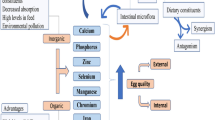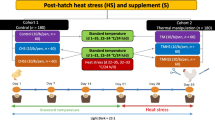Abstract
This study was conducted to determine the effects of vitamin E and selenium (Se) on lipid peroxidation (MDA), serum and liver concentration of antioxidant vitamins, and some minerals of Japanese quails reared under heat stress (34°C). One hundred twenty 10-d-old Japanese qualis (60 males, 60 females) were randomly assigned to 4 treatment groups, 3 replicates of 10 birds each. The experiment was designed in a 2×2 factorial arrangement using two levels of vitamin E (125 and 250 mg/kg of diet) and two levels of selenium (0.1 and 0.2 mg/kg of diet). Greater dietary vitamin E and selenium inclusions resulted in a greater (p=0.001) serum vitamin E and vitamin A, but lower (p=0.001) MDA concentrations. Liver vitamin E and vitamin A concentrations increased (p=0.001) and MDA concentrations decreased (p=0.001) when both dietary vitamin E and selenium increased. No interactions between vitamin E and selenium were detected (p≥0.11) for any parameters. Increasing both dietary vitamin E and selenium caused an increase in serum concentrations of Fe and Zn (p=0.001), but a decrease in serum concentration of Cu (p=0.001). Results of the present study showed that dietary vitamin E and selenium have synergistic effects and that supplementing a combination of dietary vitamin E (250 mg/kg of diet) and selenium (0.2 mg/kg of diet) offers a good management practice to reduce heat stress-related depression in performance of Japanese quails.
Similar content being viewed by others
References
D.A. Emery, P. Vohra, R.A. Ernst, and S.R. Morrison, The effect of cyclic and constant ambient temperatures on feed consumption, egg production, egg weight and shell thickness of hens, Poult. Sci. 63, 2027–2035 (1984).
B. Sauveur and M. Picard, Environmental effects on egg quality, in Egg Quality: Current Problems and Recent Advances, R.G. Wells and C.G. Belyavin, eds., Butterworths, London, pp. 219–234 (1987).
S.E. Evans and D.L. Ingram, The effect of ambient temperature upon the secretion of thyroxine in the young pig, J. Physiol. 264, 511 (1977).
S.J. Bowen and K.W. Washburn, Thyroid and adrenal response to heat stress in chickens and quail differing in heat tolerance, Poult. Sci. 64, 149–154 (1985).
L.R. McDowell, Vitamins in Animal Nutrition—Comparative Aspects to Human Nutrition. Vitamin A and E, L.R. McDowell, ed., Academic, London, pp. 10–52, 93–131 (1989).
M. Naziroğlu, K. Şahin, H. Şimşek, N. Aydilek, and O.N. Ertaş, The effect of food withdrawal and darkening on lipid peroxidation of laying hens in high ambient temperatures, Dtsch. Tierarztl. Wochenschr. 107, 199–202 (2000).
K. Şahin, O.N. Ertaş, and T. Güler, Sicaklik stresi altindaki yumurta tavuklarinda farkli yemleme yöntemlerinin vitamin A, vitamin E ile bazi kan parametreleri üzerine etkileri, Serbest Radikaller ve Antioksidanlar Araştirma Derneği II.Ulusal Kongresi, 1999, pp. 24, 58.
B.M. Freeman, Effect of stress on the ascorbic acid content of the adrenal gland of gallus domesticus, Comp. Biochem. Physiol. 23, 303–305 (1967).
K.C. Klasing, Comparative Avian Nutrition, Cambridge University Press, Cambridge, pp. 277–299 (1998).
G.F. Combs and S.B. Combs, The nutritional biochemistry of selenium, Annu. Rev. Nutr. 4, 257–280 (1984).
W.R. Beisel, Single nutrients and immunity, Am. J. Clin. Nutr. 35, 442–451 (1982).
A. Macpherson, Selenium, vitamin E and biological oxidation, in Recent Advances in Animal Nutrition, D.J. Cole and P.J. Garnsworthy, eds., Butterworth-Heinemann, Oxford. pp. 3–30 (1994).
D.C. Gallo-Torres, Absorption, blood transport and metabolism of vitamin E, in A Comprehensive Treatise, L.J. Machlin, ed., Marcel Dekker, New York, pp. 170–267 (1980).
B. Halliwell and J.M.C. Gutteridge, Free Radicals in Biology and Medicine, 2nd ed., Oxford University Press, New York (1989).
E.J. Underwood, Selenium, in Trace Elements in Human and Animal Nutrition, Academic, New York, p. 302 (1977).
G.F. Combs and S.B. Combs, The Role of Selenium in Nutrition, Academic, London, ltd. 206–312 (1986).
C.D. Mahan, How organic selenium my help reduce drip loss, World Poult. 12(11), 19–21 (1996).
R. Feenster, High temperatures decrease vitamin utilization, Misset Poultry 38, 38–41 (1985).
C.C. Whitehead, S. Bollengier-Lee, M.A. Mitchell, and P.E.V. Williams, Vitamin E can alleviate the depression in egg production in heat stressed laying hens, Proc. Spring Meeting, WPSA-UK Branch, 1998, pp. 55–56.
S. Bollengier-Lee, P.E.V. Williams, and C.C. Whitehead, Optimal dietary concentration of vitamin E for alleviating the effect of heat stress on egg production in laying hens, Br. Poult. Sci. 40, 102–107 (1999).
NRC National Research Council, Nutrient Requirements of poultry, 9th rev. ed., National Academy Press. Washington, DC (1994).
AOAC, Official Methods of Analysis, Association of Agricultural Chemists, Washington, DC (1990).
Z.A. Placer, L.L. Cushmann, and B.C. Johnson, Estimation of products of lipid peroxidation in biochemical systems, Anal. Biochem. 16, 359–364 (1966).
B. Matkovics, I. Szabo, and I.S. Varga, Determination of enzyme activities in lipid peroxidation and glutathione pathways, Lab. Diagn. 15, 248–249 (1989).
C.H. McMurray, W.J. Blanchflower, and D.A. Rice, Influence of extraction techniques on the determination of α-tocopherol in animal feedstuffs, J. Assoc. Off. Anal. Chem. 63, 1258–1261 (1980).
SAS Institute, SAS® User’s Guide: Statistics, SAS Institute Inc., Cary, NC (1989).
L. Packer and S. Landvik, Vitamin E in biological systems, in Antioxidants in Therapy and Preventive Medicine, I. Emerit, L. Packer, and A. Clair, eds., Plenum, New York, pp. 93–103 (1990).
D.J. Kornburst and R.D. Mavis, Relative susceptibility of microsomes from lung, heart, liver, kidney, brain and testes to lipid peroxidation: correlation with vitamin E content. Lipids 15, 315–320 (1980).
P.A. Morrissey, S. Brandon, D.J. Buckley, P.J.A. Sheehy, and M. Frigg, Tissue content of α-tocopherol and oxidative stability of broilers receiving dietary α-tocoperyl acetate supplement for various periods post-slaughter, Br. Poult. Sci. 38, 84–88 (1997).
G. Burton, and K.U. Ingold, β-carotene: an unusual type of lipid antioxidant, Science 224, 569–573 (1984).
A. Sunder, G. Richter, and G. Flachowsky, Influence of different concentrations of vitamin E in the feed of laying hens on the vitamin E-transfer into the egg, Proc. Soc. Nutr. Physiol. 6, 145–152 (1997).
G. Brubacher, K. Scharer, A. Studer, and O. Wiss, Uber die gegensetiege Beeinflussung von vitamin E, vitamin A and carotinoiden. Z. Ernahrungswiss. 5, 190–202 (1964).
K.F. Gey, Vitamins E plus C and interacting conutrients required for optimal health, Bio-Factors 7, 113–174 (1998).
E.J. Butler and M.J. Curtis, The effect of Escherichia coli endotoxin and ACTH on the plasma zinc concentration of the domestic fowl, Res. Vet. Sci. 15, 367–369 (1973).
L.S. Tufft and C.F. Nockles, The effects of stress, Escherichia coli, Dietary ethylenediamintetraacetic acid, and their interaction on tissue trace elements in chicks, Poult. Sci. 70, 2439–2449 (1991).
M.C., Linder, Nutrition and metabolism of the trace elements, in Nutritional biochemistry and Metabolism with Clinical Applications, M.C. Linder, ed., Elsevier, New York, pp. 215–276 (1991).
W.G. Pond, D.C. Church, and K.R. Pond.Zinc, in Basic Animal Nutrition and Feeding, 4th ed., Wiley, New York, pp. 190–193 (1995).
A. Frank, B. Pehrson, and L.R. Petersson, Concentration of some important elements in liver of young cattle supplemented with selenite enriched feed, J. Vet. Med. A 33, 421–425 (1986).
R.J. Van Saun, Rational approach to selenium supplementation essential, Feedstuffs 15, 15–18 (1990).
R.J. Kutsky, Handbook of Vitamins, Minerals and Hormones, 2nd ed., Van Nostrand Reinhold, New York, pp. 157–207 (1981).
M.E. Putnam and N. Comben, Vitamin E, Vet. Rec. 121, 541–545 (1987).
Author information
Authors and Affiliations
Rights and permissions
About this article
Cite this article
Sahin, K., Sahin, N., Yaralioglu, S. et al. Protective role of supplemental vitamin E and selenium on lipid peroxidation, vitamin E, vitamin A, and some mineral concentrations of Japanese quails reared under heat stress. Biol Trace Elem Res 85, 59–70 (2002). https://doi.org/10.1385/BTER:85:1:59
Received:
Revised:
Accepted:
Issue Date:
DOI: https://doi.org/10.1385/BTER:85:1:59




